Mobile Application Research Paper 2022
VerifiedAdded on 2022/10/19
|8
|1952
|20
AI Summary
Contribute Materials
Your contribution can guide someone’s learning journey. Share your
documents today.
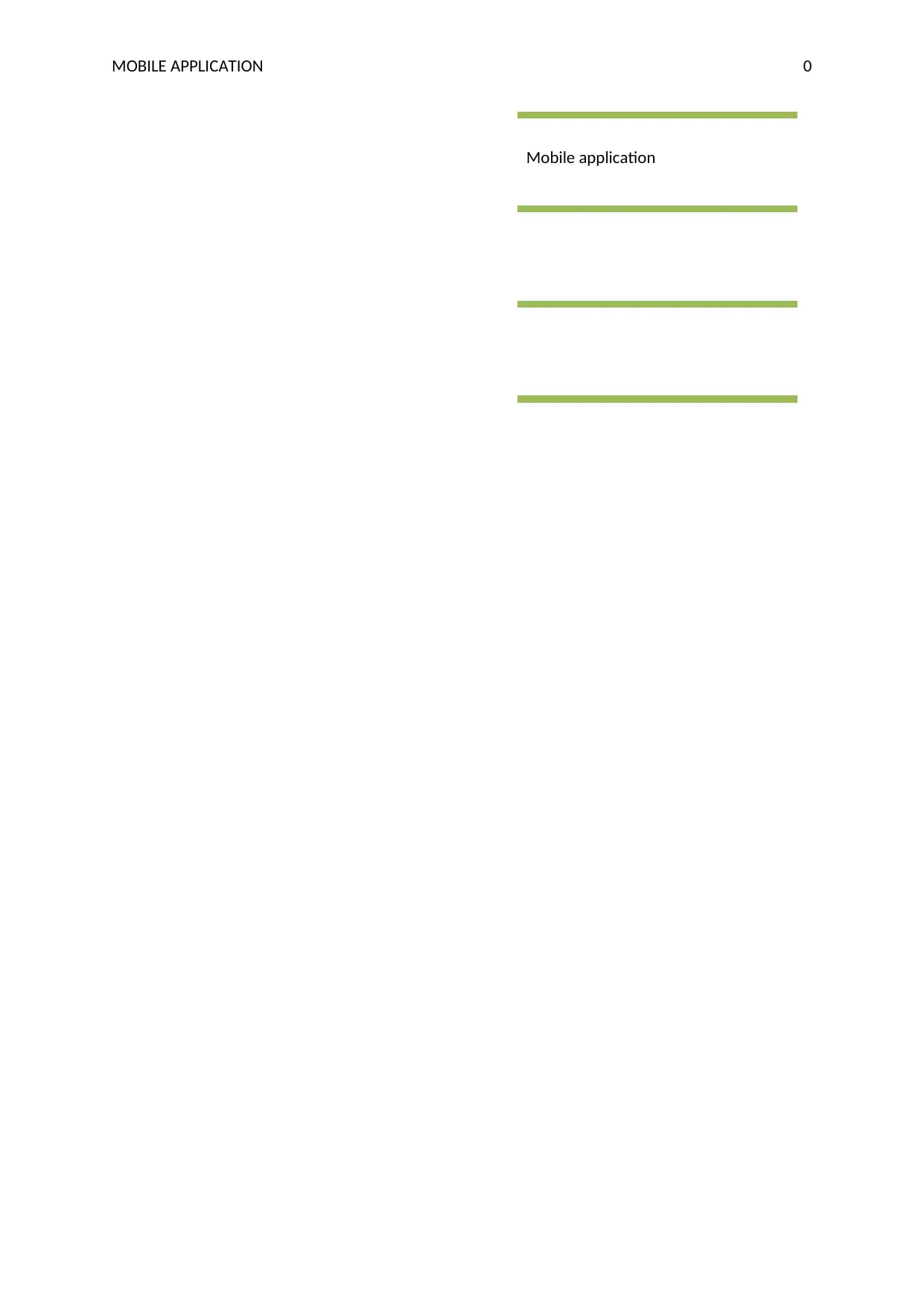
MOBILE APPLICATION 0
Mobile application
Mobile application
Secure Best Marks with AI Grader
Need help grading? Try our AI Grader for instant feedback on your assignments.
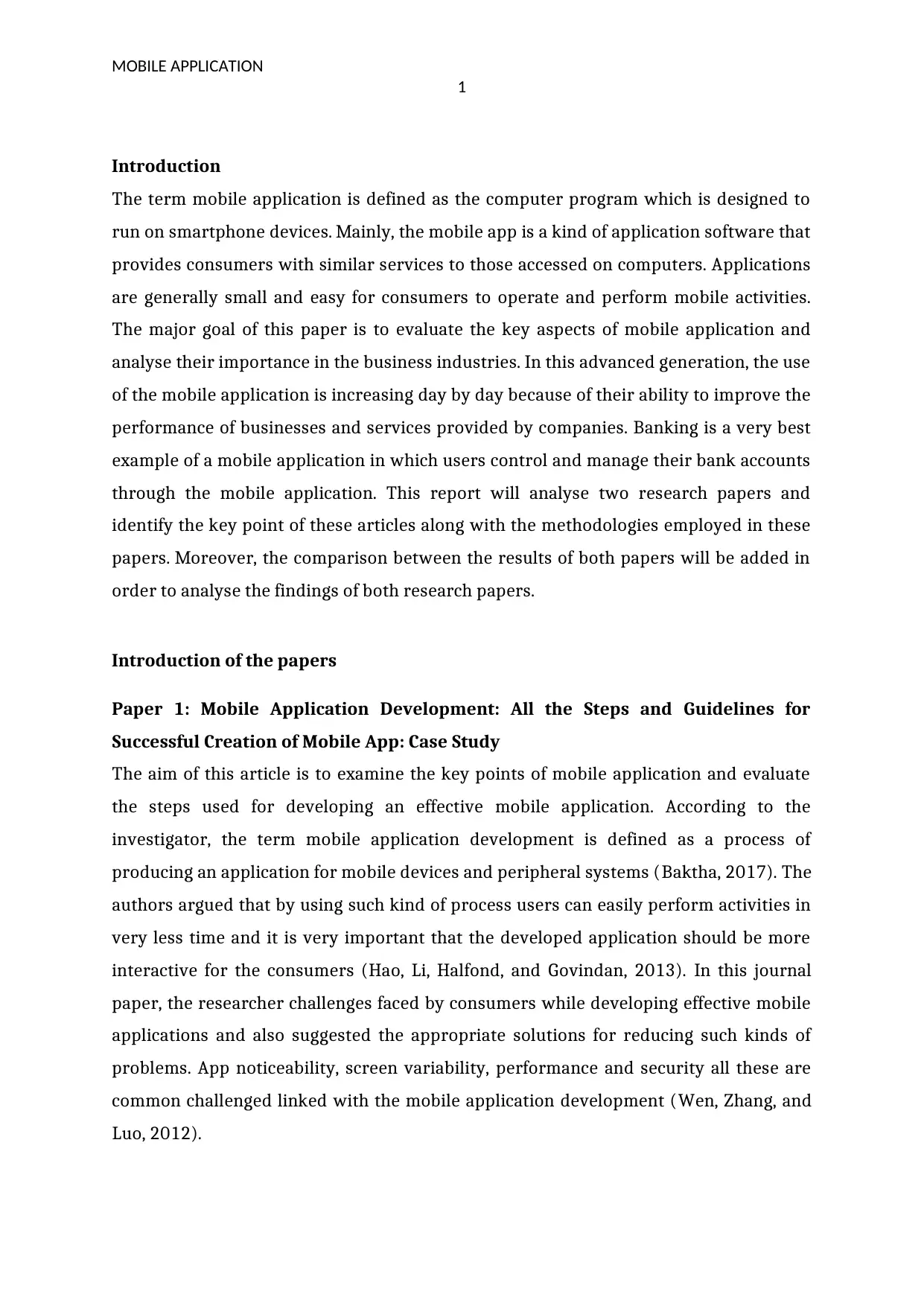
MOBILE APPLICATION
1
Introduction
The term mobile application is defined as the computer program which is designed to
run on smartphone devices. Mainly, the mobile app is a kind of application software that
provides consumers with similar services to those accessed on computers. Applications
are generally small and easy for consumers to operate and perform mobile activities.
The major goal of this paper is to evaluate the key aspects of mobile application and
analyse their importance in the business industries. In this advanced generation, the use
of the mobile application is increasing day by day because of their ability to improve the
performance of businesses and services provided by companies. Banking is a very best
example of a mobile application in which users control and manage their bank accounts
through the mobile application. This report will analyse two research papers and
identify the key point of these articles along with the methodologies employed in these
papers. Moreover, the comparison between the results of both papers will be added in
order to analyse the findings of both research papers.
Introduction of the papers
Paper 1: Mobile Application Development: All the Steps and Guidelines for
Successful Creation of Mobile App: Case Study
The aim of this article is to examine the key points of mobile application and evaluate
the steps used for developing an effective mobile application. According to the
investigator, the term mobile application development is defined as a process of
producing an application for mobile devices and peripheral systems (Baktha, 2017). The
authors argued that by using such kind of process users can easily perform activities in
very less time and it is very important that the developed application should be more
interactive for the consumers (Hao, Li, Halfond, and Govindan, 2013). In this journal
paper, the researcher challenges faced by consumers while developing effective mobile
applications and also suggested the appropriate solutions for reducing such kinds of
problems. App noticeability, screen variability, performance and security all these are
common challenged linked with the mobile application development (Wen, Zhang, and
Luo, 2012).
1
Introduction
The term mobile application is defined as the computer program which is designed to
run on smartphone devices. Mainly, the mobile app is a kind of application software that
provides consumers with similar services to those accessed on computers. Applications
are generally small and easy for consumers to operate and perform mobile activities.
The major goal of this paper is to evaluate the key aspects of mobile application and
analyse their importance in the business industries. In this advanced generation, the use
of the mobile application is increasing day by day because of their ability to improve the
performance of businesses and services provided by companies. Banking is a very best
example of a mobile application in which users control and manage their bank accounts
through the mobile application. This report will analyse two research papers and
identify the key point of these articles along with the methodologies employed in these
papers. Moreover, the comparison between the results of both papers will be added in
order to analyse the findings of both research papers.
Introduction of the papers
Paper 1: Mobile Application Development: All the Steps and Guidelines for
Successful Creation of Mobile App: Case Study
The aim of this article is to examine the key points of mobile application and evaluate
the steps used for developing an effective mobile application. According to the
investigator, the term mobile application development is defined as a process of
producing an application for mobile devices and peripheral systems (Baktha, 2017). The
authors argued that by using such kind of process users can easily perform activities in
very less time and it is very important that the developed application should be more
interactive for the consumers (Hao, Li, Halfond, and Govindan, 2013). In this journal
paper, the researcher challenges faced by consumers while developing effective mobile
applications and also suggested the appropriate solutions for reducing such kinds of
problems. App noticeability, screen variability, performance and security all these are
common challenged linked with the mobile application development (Wen, Zhang, and
Luo, 2012).
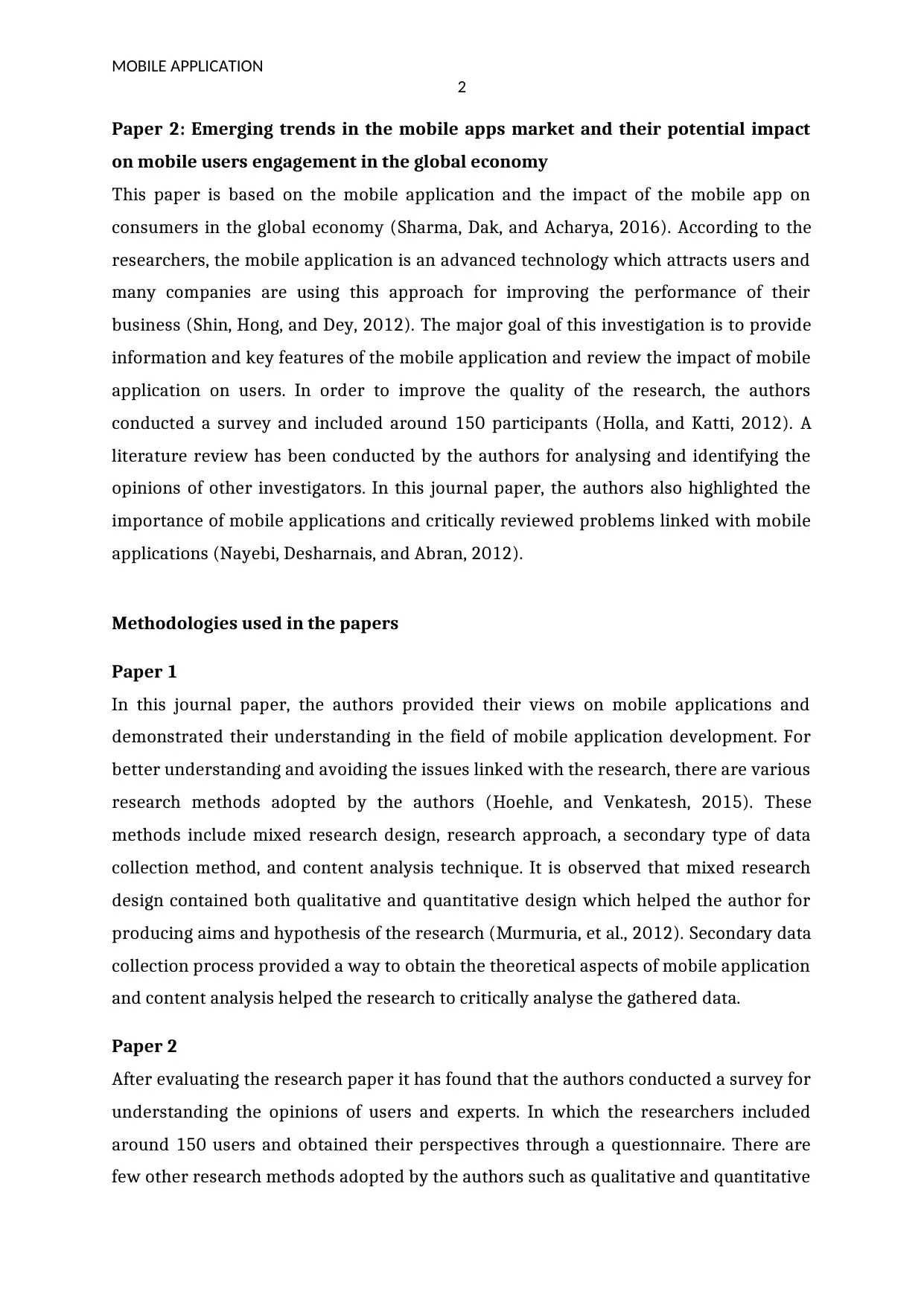
MOBILE APPLICATION
2
Paper 2: Emerging trends in the mobile apps market and their potential impact
on mobile users engagement in the global economy
This paper is based on the mobile application and the impact of the mobile app on
consumers in the global economy (Sharma, Dak, and Acharya, 2016). According to the
researchers, the mobile application is an advanced technology which attracts users and
many companies are using this approach for improving the performance of their
business (Shin, Hong, and Dey, 2012). The major goal of this investigation is to provide
information and key features of the mobile application and review the impact of mobile
application on users. In order to improve the quality of the research, the authors
conducted a survey and included around 150 participants (Holla, and Katti, 2012). A
literature review has been conducted by the authors for analysing and identifying the
opinions of other investigators. In this journal paper, the authors also highlighted the
importance of mobile applications and critically reviewed problems linked with mobile
applications (Nayebi, Desharnais, and Abran, 2012).
Methodologies used in the papers
Paper 1
In this journal paper, the authors provided their views on mobile applications and
demonstrated their understanding in the field of mobile application development. For
better understanding and avoiding the issues linked with the research, there are various
research methods adopted by the authors (Hoehle, and Venkatesh, 2015). These
methods include mixed research design, research approach, a secondary type of data
collection method, and content analysis technique. It is observed that mixed research
design contained both qualitative and quantitative design which helped the author for
producing aims and hypothesis of the research (Murmuria, et al., 2012). Secondary data
collection process provided a way to obtain the theoretical aspects of mobile application
and content analysis helped the research to critically analyse the gathered data.
Paper 2
After evaluating the research paper it has found that the authors conducted a survey for
understanding the opinions of users and experts. In which the researchers included
around 150 users and obtained their perspectives through a questionnaire. There are
few other research methods adopted by the authors such as qualitative and quantitative
2
Paper 2: Emerging trends in the mobile apps market and their potential impact
on mobile users engagement in the global economy
This paper is based on the mobile application and the impact of the mobile app on
consumers in the global economy (Sharma, Dak, and Acharya, 2016). According to the
researchers, the mobile application is an advanced technology which attracts users and
many companies are using this approach for improving the performance of their
business (Shin, Hong, and Dey, 2012). The major goal of this investigation is to provide
information and key features of the mobile application and review the impact of mobile
application on users. In order to improve the quality of the research, the authors
conducted a survey and included around 150 participants (Holla, and Katti, 2012). A
literature review has been conducted by the authors for analysing and identifying the
opinions of other investigators. In this journal paper, the authors also highlighted the
importance of mobile applications and critically reviewed problems linked with mobile
applications (Nayebi, Desharnais, and Abran, 2012).
Methodologies used in the papers
Paper 1
In this journal paper, the authors provided their views on mobile applications and
demonstrated their understanding in the field of mobile application development. For
better understanding and avoiding the issues linked with the research, there are various
research methods adopted by the authors (Hoehle, and Venkatesh, 2015). These
methods include mixed research design, research approach, a secondary type of data
collection method, and content analysis technique. It is observed that mixed research
design contained both qualitative and quantitative design which helped the author for
producing aims and hypothesis of the research (Murmuria, et al., 2012). Secondary data
collection process provided a way to obtain the theoretical aspects of mobile application
and content analysis helped the research to critically analyse the gathered data.
Paper 2
After evaluating the research paper it has found that the authors conducted a survey for
understanding the opinions of users and experts. In which the researchers included
around 150 users and obtained their perspectives through a questionnaire. There are
few other research methods adopted by the authors such as qualitative and quantitative
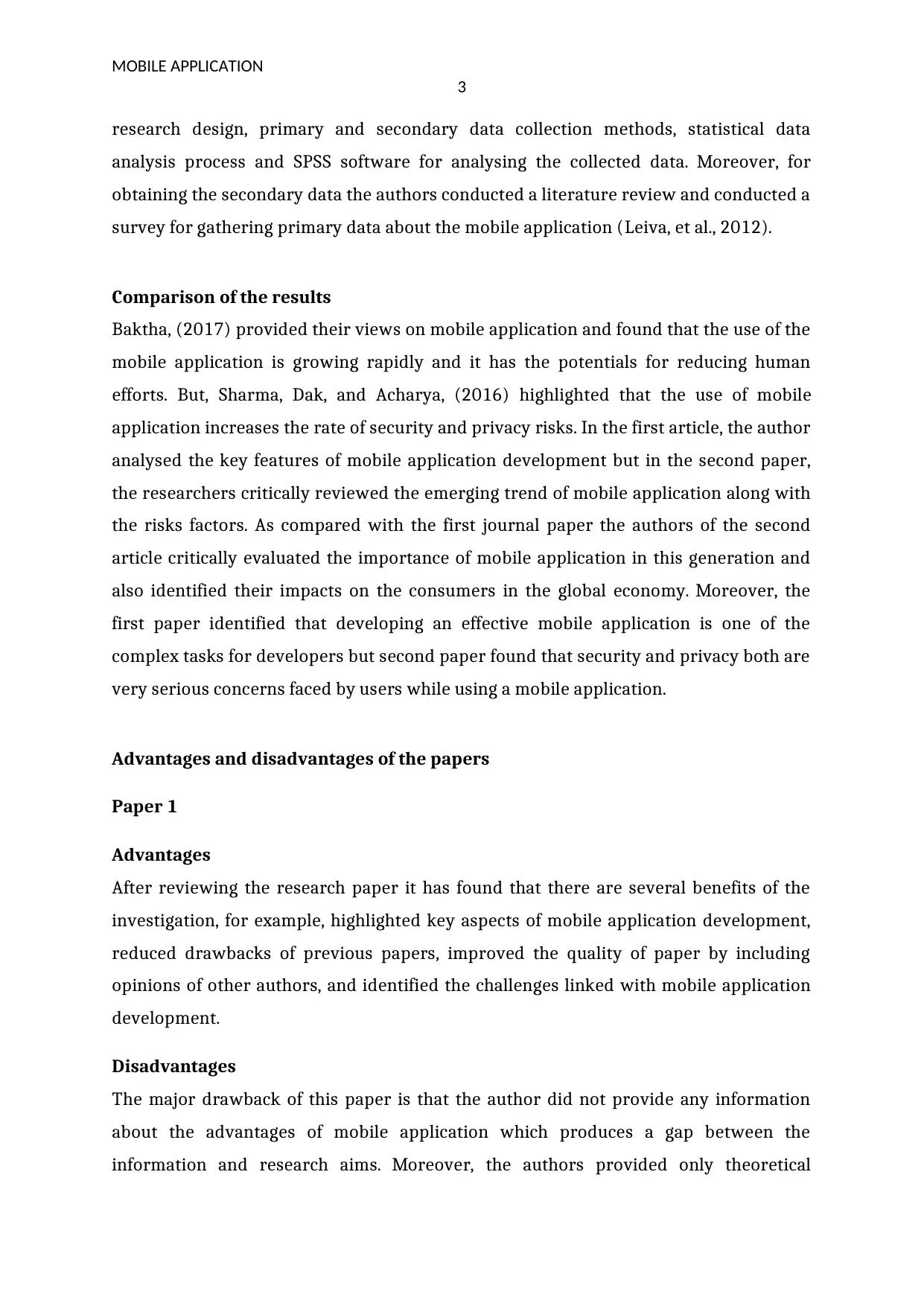
MOBILE APPLICATION
3
research design, primary and secondary data collection methods, statistical data
analysis process and SPSS software for analysing the collected data. Moreover, for
obtaining the secondary data the authors conducted a literature review and conducted a
survey for gathering primary data about the mobile application (Leiva, et al., 2012).
Comparison of the results
Baktha, (2017) provided their views on mobile application and found that the use of the
mobile application is growing rapidly and it has the potentials for reducing human
efforts. But, Sharma, Dak, and Acharya, (2016) highlighted that the use of mobile
application increases the rate of security and privacy risks. In the first article, the author
analysed the key features of mobile application development but in the second paper,
the researchers critically reviewed the emerging trend of mobile application along with
the risks factors. As compared with the first journal paper the authors of the second
article critically evaluated the importance of mobile application in this generation and
also identified their impacts on the consumers in the global economy. Moreover, the
first paper identified that developing an effective mobile application is one of the
complex tasks for developers but second paper found that security and privacy both are
very serious concerns faced by users while using a mobile application.
Advantages and disadvantages of the papers
Paper 1
Advantages
After reviewing the research paper it has found that there are several benefits of the
investigation, for example, highlighted key aspects of mobile application development,
reduced drawbacks of previous papers, improved the quality of paper by including
opinions of other authors, and identified the challenges linked with mobile application
development.
Disadvantages
The major drawback of this paper is that the author did not provide any information
about the advantages of mobile application which produces a gap between the
information and research aims. Moreover, the authors provided only theoretical
3
research design, primary and secondary data collection methods, statistical data
analysis process and SPSS software for analysing the collected data. Moreover, for
obtaining the secondary data the authors conducted a literature review and conducted a
survey for gathering primary data about the mobile application (Leiva, et al., 2012).
Comparison of the results
Baktha, (2017) provided their views on mobile application and found that the use of the
mobile application is growing rapidly and it has the potentials for reducing human
efforts. But, Sharma, Dak, and Acharya, (2016) highlighted that the use of mobile
application increases the rate of security and privacy risks. In the first article, the author
analysed the key features of mobile application development but in the second paper,
the researchers critically reviewed the emerging trend of mobile application along with
the risks factors. As compared with the first journal paper the authors of the second
article critically evaluated the importance of mobile application in this generation and
also identified their impacts on the consumers in the global economy. Moreover, the
first paper identified that developing an effective mobile application is one of the
complex tasks for developers but second paper found that security and privacy both are
very serious concerns faced by users while using a mobile application.
Advantages and disadvantages of the papers
Paper 1
Advantages
After reviewing the research paper it has found that there are several benefits of the
investigation, for example, highlighted key aspects of mobile application development,
reduced drawbacks of previous papers, improved the quality of paper by including
opinions of other authors, and identified the challenges linked with mobile application
development.
Disadvantages
The major drawback of this paper is that the author did not provide any information
about the advantages of mobile application which produces a gap between the
information and research aims. Moreover, the authors provided only theoretical
Secure Best Marks with AI Grader
Need help grading? Try our AI Grader for instant feedback on your assignments.
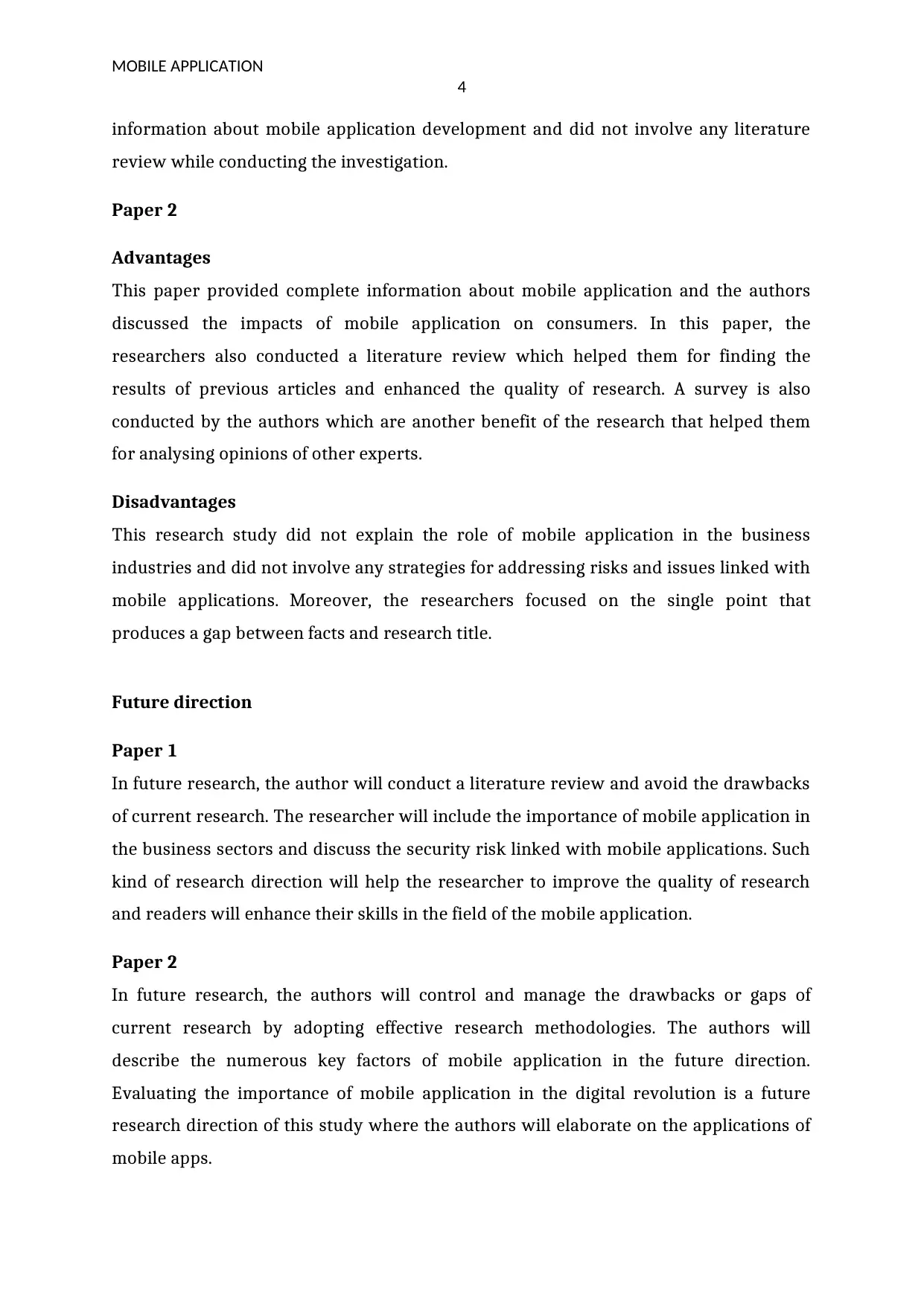
MOBILE APPLICATION
4
information about mobile application development and did not involve any literature
review while conducting the investigation.
Paper 2
Advantages
This paper provided complete information about mobile application and the authors
discussed the impacts of mobile application on consumers. In this paper, the
researchers also conducted a literature review which helped them for finding the
results of previous articles and enhanced the quality of research. A survey is also
conducted by the authors which are another benefit of the research that helped them
for analysing opinions of other experts.
Disadvantages
This research study did not explain the role of mobile application in the business
industries and did not involve any strategies for addressing risks and issues linked with
mobile applications. Moreover, the researchers focused on the single point that
produces a gap between facts and research title.
Future direction
Paper 1
In future research, the author will conduct a literature review and avoid the drawbacks
of current research. The researcher will include the importance of mobile application in
the business sectors and discuss the security risk linked with mobile applications. Such
kind of research direction will help the researcher to improve the quality of research
and readers will enhance their skills in the field of the mobile application.
Paper 2
In future research, the authors will control and manage the drawbacks or gaps of
current research by adopting effective research methodologies. The authors will
describe the numerous key factors of mobile application in the future direction.
Evaluating the importance of mobile application in the digital revolution is a future
research direction of this study where the authors will elaborate on the applications of
mobile apps.
4
information about mobile application development and did not involve any literature
review while conducting the investigation.
Paper 2
Advantages
This paper provided complete information about mobile application and the authors
discussed the impacts of mobile application on consumers. In this paper, the
researchers also conducted a literature review which helped them for finding the
results of previous articles and enhanced the quality of research. A survey is also
conducted by the authors which are another benefit of the research that helped them
for analysing opinions of other experts.
Disadvantages
This research study did not explain the role of mobile application in the business
industries and did not involve any strategies for addressing risks and issues linked with
mobile applications. Moreover, the researchers focused on the single point that
produces a gap between facts and research title.
Future direction
Paper 1
In future research, the author will conduct a literature review and avoid the drawbacks
of current research. The researcher will include the importance of mobile application in
the business sectors and discuss the security risk linked with mobile applications. Such
kind of research direction will help the researcher to improve the quality of research
and readers will enhance their skills in the field of the mobile application.
Paper 2
In future research, the authors will control and manage the drawbacks or gaps of
current research by adopting effective research methodologies. The authors will
describe the numerous key factors of mobile application in the future direction.
Evaluating the importance of mobile application in the digital revolution is a future
research direction of this study where the authors will elaborate on the applications of
mobile apps.
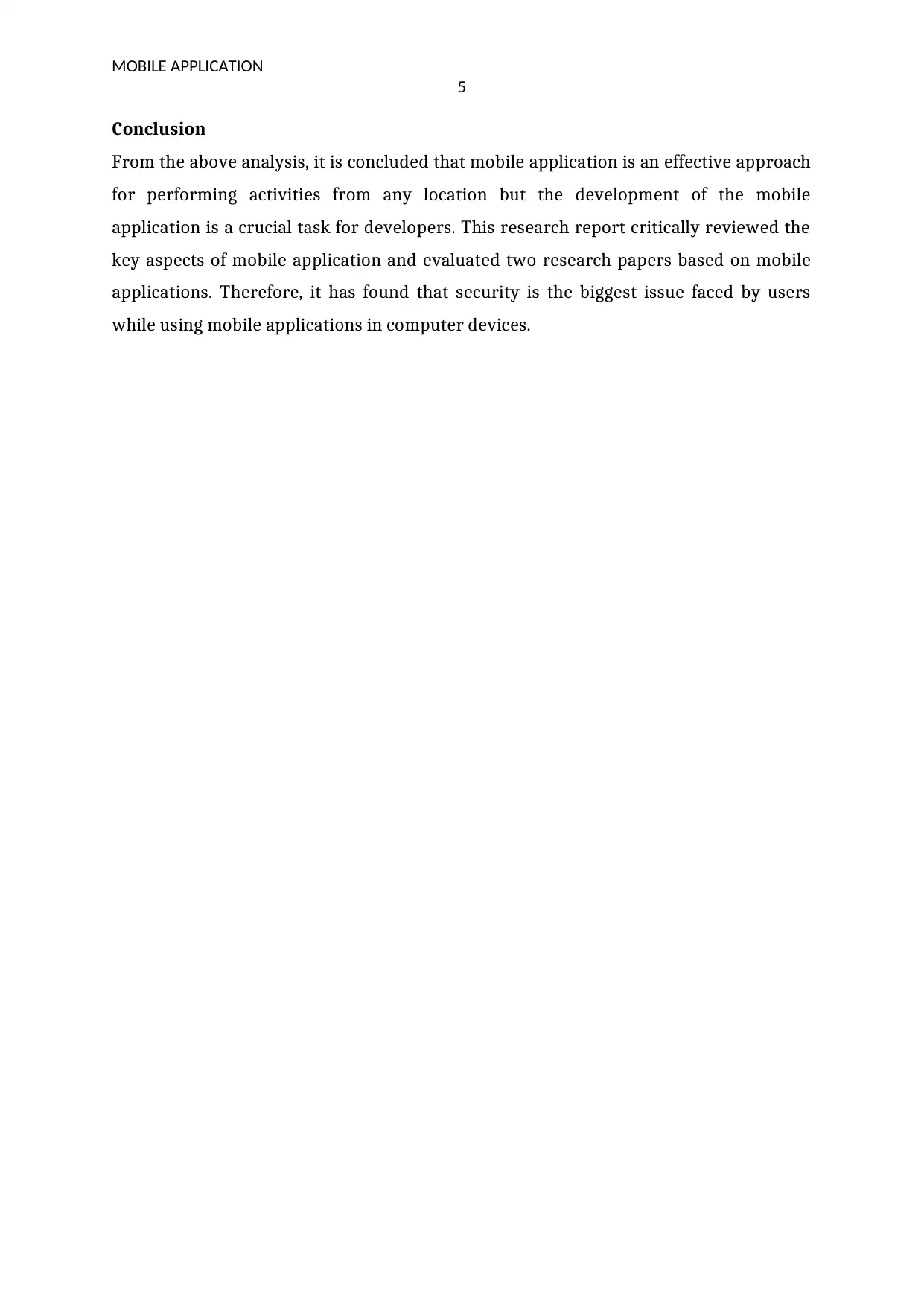
MOBILE APPLICATION
5
Conclusion
From the above analysis, it is concluded that mobile application is an effective approach
for performing activities from any location but the development of the mobile
application is a crucial task for developers. This research report critically reviewed the
key aspects of mobile application and evaluated two research papers based on mobile
applications. Therefore, it has found that security is the biggest issue faced by users
while using mobile applications in computer devices.
5
Conclusion
From the above analysis, it is concluded that mobile application is an effective approach
for performing activities from any location but the development of the mobile
application is a crucial task for developers. This research report critically reviewed the
key aspects of mobile application and evaluated two research papers based on mobile
applications. Therefore, it has found that security is the biggest issue faced by users
while using mobile applications in computer devices.
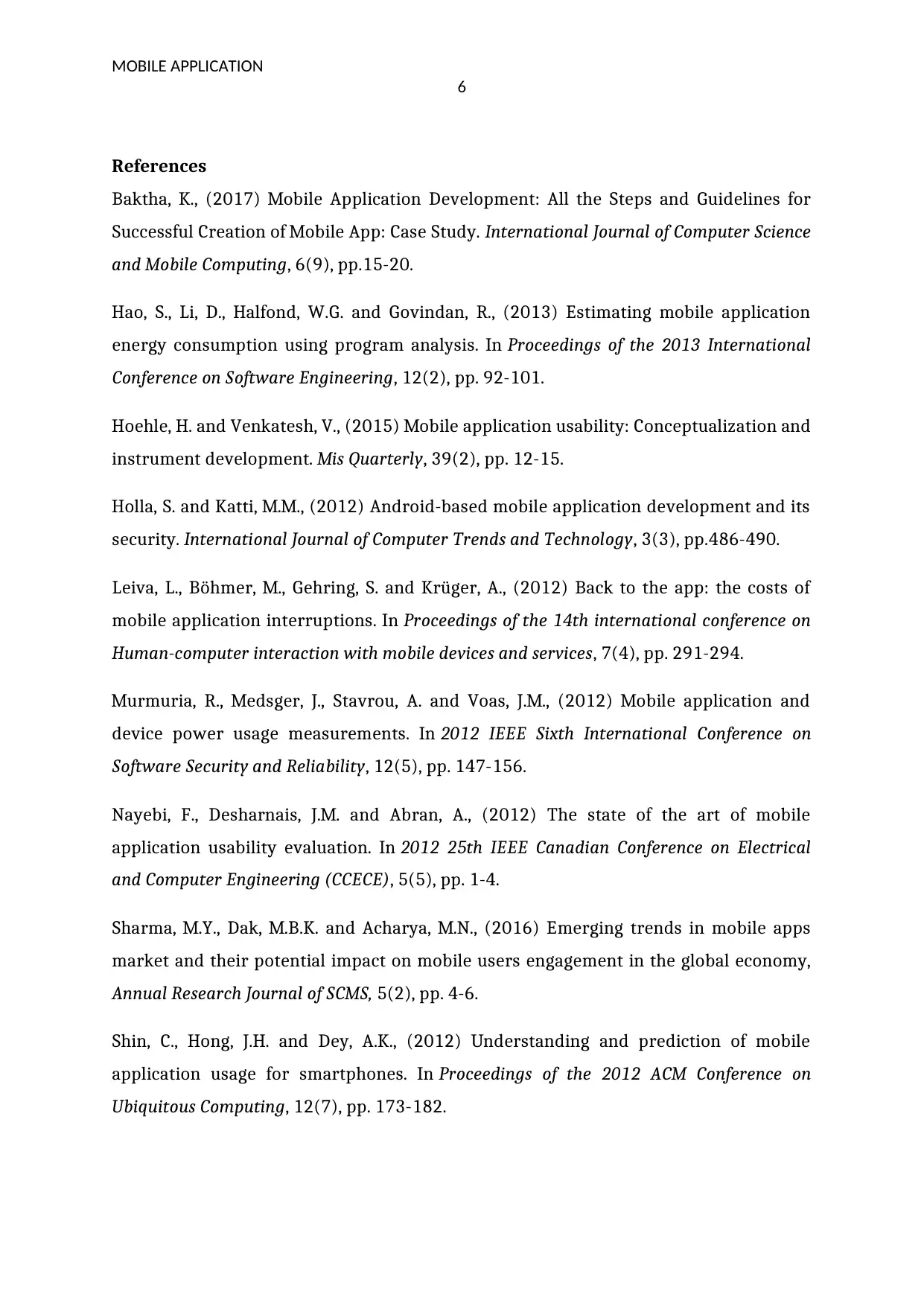
MOBILE APPLICATION
6
References
Baktha, K., (2017) Mobile Application Development: All the Steps and Guidelines for
Successful Creation of Mobile App: Case Study. International Journal of Computer Science
and Mobile Computing, 6(9), pp.15-20.
Hao, S., Li, D., Halfond, W.G. and Govindan, R., (2013) Estimating mobile application
energy consumption using program analysis. In Proceedings of the 2013 International
Conference on Software Engineering, 12(2), pp. 92-101.
Hoehle, H. and Venkatesh, V., (2015) Mobile application usability: Conceptualization and
instrument development. Mis Quarterly, 39(2), pp. 12-15.
Holla, S. and Katti, M.M., (2012) Android-based mobile application development and its
security. International Journal of Computer Trends and Technology, 3(3), pp.486-490.
Leiva, L., Böhmer, M., Gehring, S. and Krüger, A., (2012) Back to the app: the costs of
mobile application interruptions. In Proceedings of the 14th international conference on
Human-computer interaction with mobile devices and services, 7(4), pp. 291-294.
Murmuria, R., Medsger, J., Stavrou, A. and Voas, J.M., (2012) Mobile application and
device power usage measurements. In 2012 IEEE Sixth International Conference on
Software Security and Reliability, 12(5), pp. 147-156.
Nayebi, F., Desharnais, J.M. and Abran, A., (2012) The state of the art of mobile
application usability evaluation. In 2012 25th IEEE Canadian Conference on Electrical
and Computer Engineering (CCECE), 5(5), pp. 1-4.
Sharma, M.Y., Dak, M.B.K. and Acharya, M.N., (2016) Emerging trends in mobile apps
market and their potential impact on mobile users engagement in the global economy,
Annual Research Journal of SCMS, 5(2), pp. 4-6.
Shin, C., Hong, J.H. and Dey, A.K., (2012) Understanding and prediction of mobile
application usage for smartphones. In Proceedings of the 2012 ACM Conference on
Ubiquitous Computing, 12(7), pp. 173-182.
6
References
Baktha, K., (2017) Mobile Application Development: All the Steps and Guidelines for
Successful Creation of Mobile App: Case Study. International Journal of Computer Science
and Mobile Computing, 6(9), pp.15-20.
Hao, S., Li, D., Halfond, W.G. and Govindan, R., (2013) Estimating mobile application
energy consumption using program analysis. In Proceedings of the 2013 International
Conference on Software Engineering, 12(2), pp. 92-101.
Hoehle, H. and Venkatesh, V., (2015) Mobile application usability: Conceptualization and
instrument development. Mis Quarterly, 39(2), pp. 12-15.
Holla, S. and Katti, M.M., (2012) Android-based mobile application development and its
security. International Journal of Computer Trends and Technology, 3(3), pp.486-490.
Leiva, L., Böhmer, M., Gehring, S. and Krüger, A., (2012) Back to the app: the costs of
mobile application interruptions. In Proceedings of the 14th international conference on
Human-computer interaction with mobile devices and services, 7(4), pp. 291-294.
Murmuria, R., Medsger, J., Stavrou, A. and Voas, J.M., (2012) Mobile application and
device power usage measurements. In 2012 IEEE Sixth International Conference on
Software Security and Reliability, 12(5), pp. 147-156.
Nayebi, F., Desharnais, J.M. and Abran, A., (2012) The state of the art of mobile
application usability evaluation. In 2012 25th IEEE Canadian Conference on Electrical
and Computer Engineering (CCECE), 5(5), pp. 1-4.
Sharma, M.Y., Dak, M.B.K. and Acharya, M.N., (2016) Emerging trends in mobile apps
market and their potential impact on mobile users engagement in the global economy,
Annual Research Journal of SCMS, 5(2), pp. 4-6.
Shin, C., Hong, J.H. and Dey, A.K., (2012) Understanding and prediction of mobile
application usage for smartphones. In Proceedings of the 2012 ACM Conference on
Ubiquitous Computing, 12(7), pp. 173-182.
Paraphrase This Document
Need a fresh take? Get an instant paraphrase of this document with our AI Paraphraser
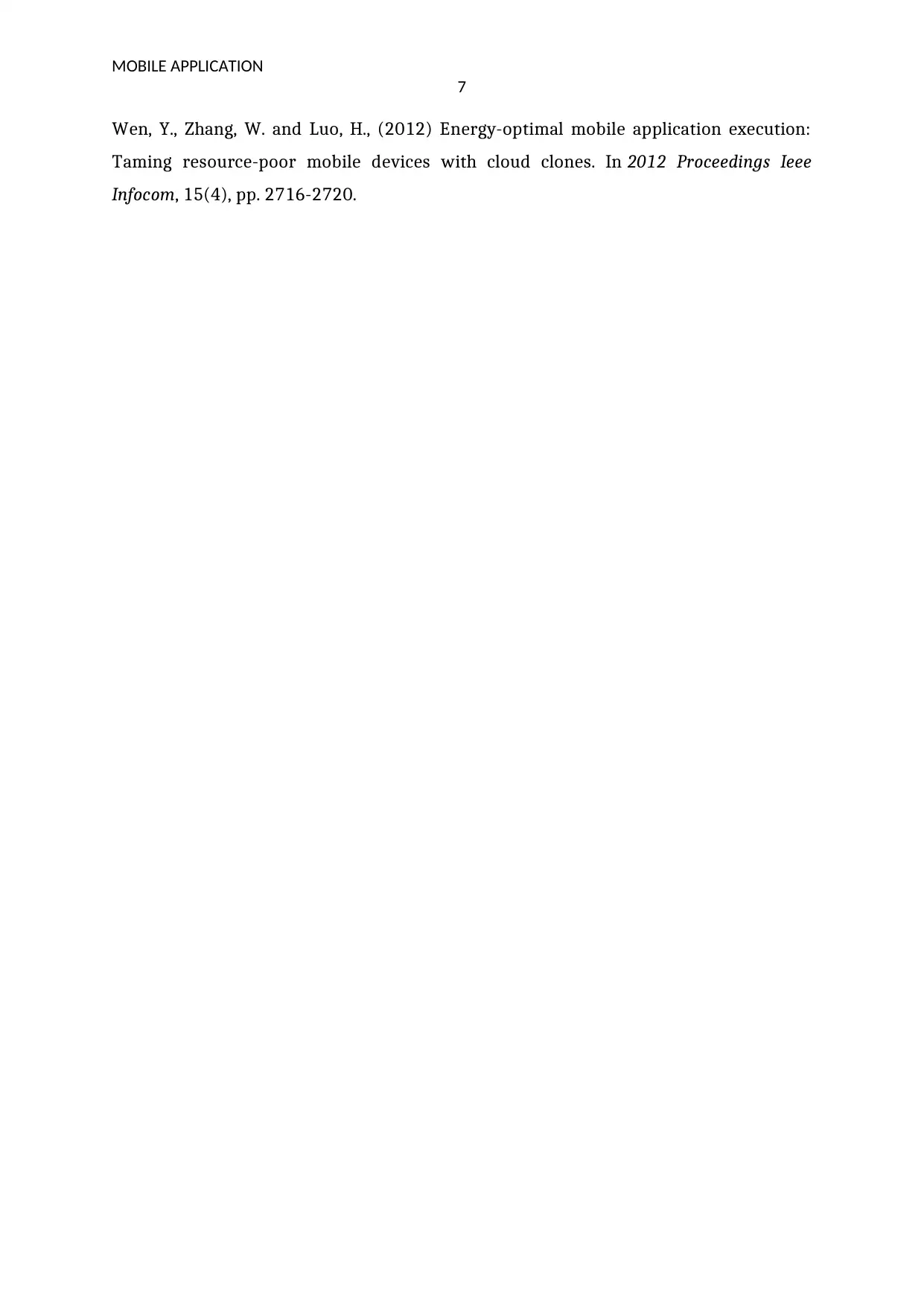
MOBILE APPLICATION
7
Wen, Y., Zhang, W. and Luo, H., (2012) Energy-optimal mobile application execution:
Taming resource-poor mobile devices with cloud clones. In 2012 Proceedings Ieee
Infocom, 15(4), pp. 2716-2720.
7
Wen, Y., Zhang, W. and Luo, H., (2012) Energy-optimal mobile application execution:
Taming resource-poor mobile devices with cloud clones. In 2012 Proceedings Ieee
Infocom, 15(4), pp. 2716-2720.
1 out of 8
Related Documents
Your All-in-One AI-Powered Toolkit for Academic Success.
+13062052269
info@desklib.com
Available 24*7 on WhatsApp / Email
![[object Object]](/_next/static/media/star-bottom.7253800d.svg)
Unlock your academic potential
© 2024 | Zucol Services PVT LTD | All rights reserved.





